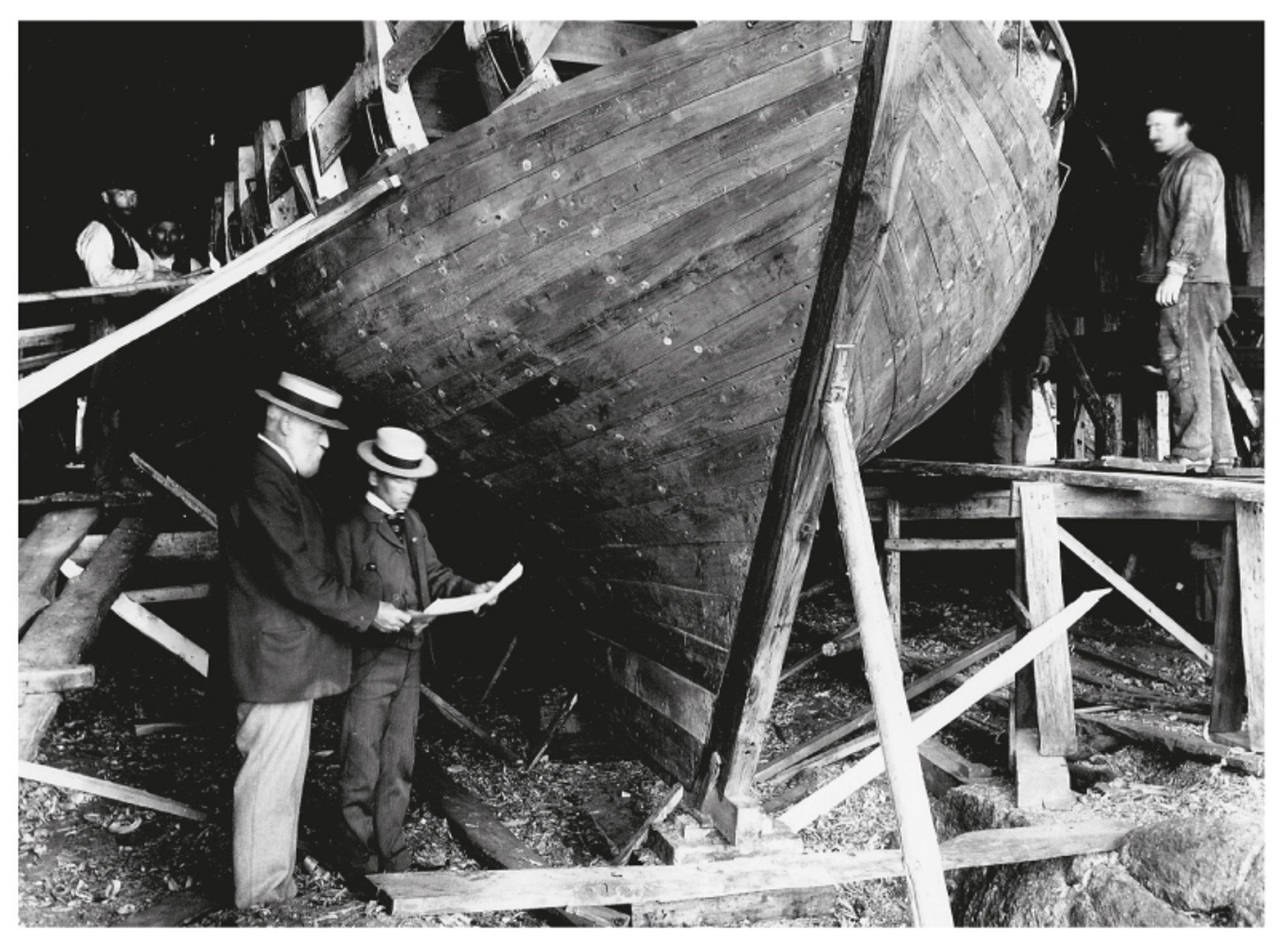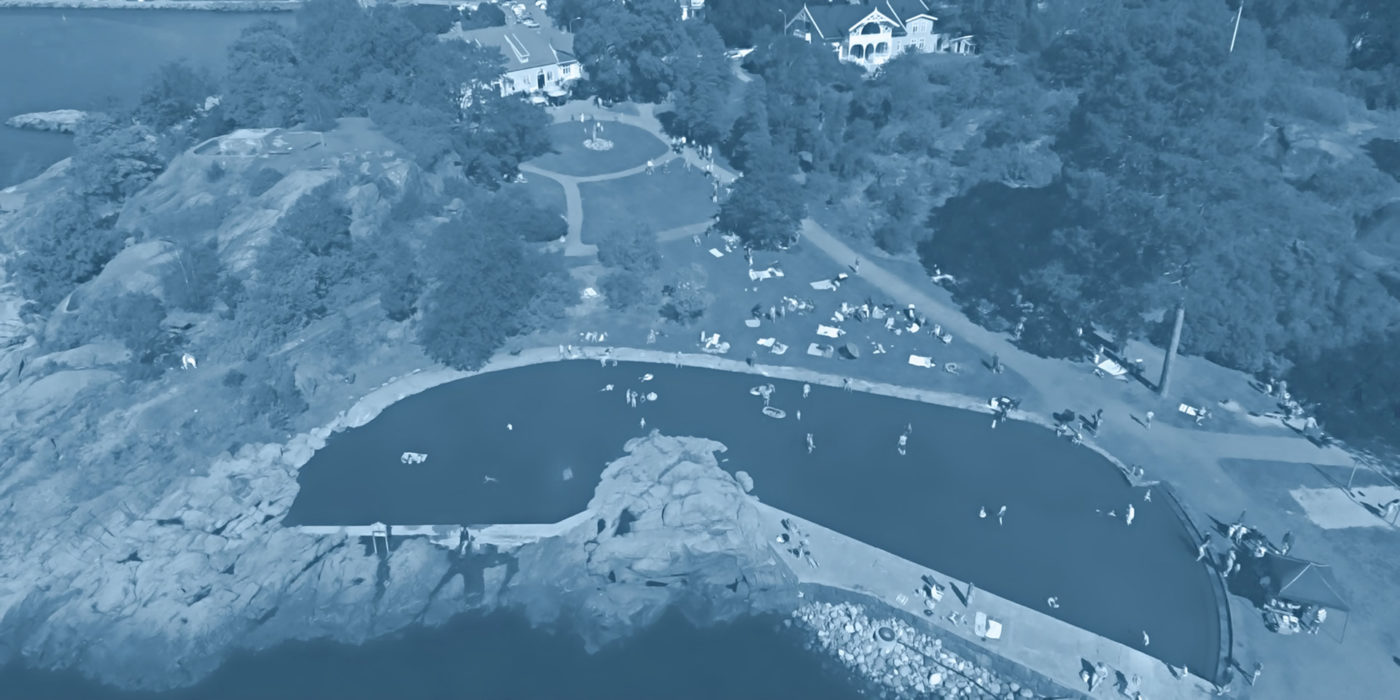COLIN ARCHER – A GIANT.
Thanks to Colin Archer, life at sea became safer for many. The properties of his pilot boats and rescue vessels remain a formidable contribution to better safety at sea. The pilot boats, and later the rescue vessels were revolutionary in sailing capacity and seaworthiness, such as the world had not yet seen.
In all, Colin Archer built more than 200 vessels, of these nearly 60 pilot boats, 14 rescue vessels and 4 ships, in addition to a large number of fishing boats and pleasure crafts. One of the most outstanding yachts was “Jærbuen”, built here at Tollerodden in 1898 for the great seafarer Wilhelm Wolf. “Jærbuen” has her home harbour here at Skottebrygga.

ADOLESCENCE.
The Archer family sailed into the Larvik fjord by their family schooner “Pomona” for the first time in 1825. Their timber business in Scotland had been heavy going, so William Archer and his wife Julia Walker, together with seven of their eight children set sail for Norway and Larvik. After having spent their first year at Langestrand, they moved across the fjord to the house now known as Tollerodden (Kirkestredet 9), which had been the home and office of custom officers and merchants. The building dates from about 1660. Here Colin was born 22th July 1832, as the youngest but one of 13 children.
As did his eight brothers before him, Colin also left for Australia to work on the family sheep farms in what is now Queensland. For the 17-year-old Colin, the journey there lasted three years. After a dramatic voyage across the Atlantic, he went ashore in Panama, before proceeding to Australia, he went up to California to try his luck as a gold digger along with one of his brothers. He also spent some time on Hawaii, where another brother had a tobacco farm, before arriving at last in Australia in 1852.
BACK AT TOLLERODDEN
In 1861 he again arrived in Larvik. He married Karen Sophie Wiborg, and they had their own house, Lilleodden, built next to Tollerodden, his childhood home. The couple had 5 children. Colin Archer died Feb 8th, 1921, at the age of 88.
He lived and worked here at Tollerodden. Here in the bay of the beautiful Larvik fjord, Archer and his many workers built more than 200 vessels. The Polar ship “Fram”, which was used by both Frithjof Nansen and Roald Amundsen on their polar expeditions, was built at Laurvigs Strandverft in Rekkeviksbukta, a little further out in the Larvik fjord. Three other larger ships were also built there.
His interest in boat construction came at an early age. Contrary to many boatbuilders who relied on knowledge and craftmanship passed on from one generation to the next, and with tradition as the most important guide, Colin Archer had a more scientific approach. In his atelier at Lilleodden, he designed and modeled his vessels before building them. The shipyard, with slipways and buildings, was established in the area north of Tollerodden, towards Skottebrygga and the town. Colin Archer mastered English well and had dialogues about boat construction and ship building in an international maritime circle.
THE FIRST CUTTERS.
Properties at sea were the foremost considerations when Archer constructed a vessel. A pilot boat should be strong at sea, but also able to sail effectively and rapidly. Before the first pilot cutter was ready in 1872, he had been inspired to construct pleasure crafts from abroad. But “Hvalerskøyta”, with Archer`s own modifications of the hull below the waterline, was the base for the first pilot boat of Archer`s design. Pilot boat no. 1, “Pilen”, was sold to the pilot Johan NIlsen from Nøtterøy.
Parallel to developing pilot boats, Archer also built cutters for use in regattas and pleasure sailing. The family boat, “Marina”, was launched in 1873. The boat had modern lines, was well equipped in the cockpit and was in many ways a good advertisement for Archer.
THE HERO OF THE POLAR HEROES.
The slipway at Tollerodden was too small for building larger ships. When Colin Archer engaged himself in building sailing ships, he established Laurvigs Strandverft at Rekkevik. The first schooner was launched in 1875. In 1892, the important commission from Frithof Nansen, the polar ship “Fram”, was launched under great festivities. “Fram” was instrumental in making world history. Nansen expressed his confidence in Colin Archer in this way: “Each time the ice screwed up around “Fram”, and at the noisy sound of cracking, I sent a thankful and confident thought to this clever, whitehaired head in Larvik”. The polar ship “Fram” can be visited at Bygdøy in Oslo, where it is well taken care of by the Fram Museum.
A PIONEER IN RESCUE WORK AT SEA.
Regardless the success and attention with sail ships, Archer was foremost interested in pilot boats. He continued to develop and improve new constructions. Many elements and details were important. When the cutters were given more ballast and an iron keel, and Archer changed from clinkerbuild to cravel built, his cutters were groundbreaking. At a regatta for pilot boats in Arendal in 1886, his boats won the top four places.
As the 19th century was coming to an end, the demand for better rescue contingency along the long Norwegian coast grew stronger. The number of fishermen drowning during heavy storms at sea, was incredibly high.
As an example, about 500 fishermen drowned during the Lofoten fishing season in 1849.
ESTABLISHING THE NORWEGIAN SOCIETY FOR SEA RESCUE.
In January 1889 a group of people dedicated for the sea rescue cause gathered in the rooms of Christiania Merchants Society. The agenda was to form a countrywide rescue society. Among them was Colin Archer from Larvik.
The Norwegian Society for the Rescue at Sea was established the 9th of July 1891. It was decided that specially designed rescue vessels should be built. After a design competion, where Colin Archer was in the jury, a cutter, designed by C.L. Stephansen from Arendal won the competion. However, the society still wanted Colin Archer to build a boat of his own construction. Both boats were built. In later years, Archer`s construction was the model for most of the rescue boats under sail.
All his life, Archer searched for improvements, enhancing his reputation as a great boat constructor. His boats were not only good and safe sailing cutters, but also aesthetically well built, both for plain and stormy sailing.
THE COMMUNITY CONSTRUCTOR.
Colin Archer had an enormous work capacity, and he put his talents to use for the betterment of the society around him.
In addition to his significance in local, national and international maritime history, he was also an important figure in the social life of Larvik. He played the cello in the local chamber orchestra, engaged in local politics and became the mayor of Larvik for a period. For many years he held positions in the Laurvig Sparebank, first as chairman from 1895 – 1906, and then as chair of the governors from 1907 – 1916. He was also a co-establisher, chairman or board member in the Royal Norwegian Sailing Society, Færder Pilots` Society, the local branch of the Rescue at Sea Society, Larvik Sailing Society, Larvik Seamen Association and The Committee for the Sea Rescue Cause.
Archer was honoured by many. He was appointed Knight of the Order of St. Olav for his work with the pilot boats and promoted to Commander of the same order after the “Fram” effort. He has also been honoured with stamp issues, and the rescue vessel RS 14 “Stavanger”, which he built here in 1901, is the main motive on the current Norwegian 500 kroner note. This vessel is now owned by the Tollerodden Foundation and is situated in the boat shelter here at Tollerodden.

